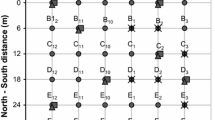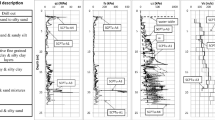Abstract
Cone penetration test (CPT) is probably the most popular in situ testing method in the world today. Various design parameters, such as undrained strength and relative density, as well as indices for liquefaction assessment, can be derived from the CPT. However, the use of CPT in many roading projects and in subdivision developments may be constrained by the number of tests or project cost; hence, alternative in situ testing technique to supplement the CPT is necessary. Screw Driving Sounding (SDS) is a new in situ test in which a machine drills a screw point into the ground in several loading steps while the attached rod is continuously rotated. During the test, a number of parameters, such as torque, load, speed of penetration and friction, are measured at every rotation of the rod; these provide a robust way of characterising soil stratigraphy. In this paper, the principle of SDS testing is described. SDS tests were performed at various sites in New Zealand where CPT data are available. Then, a side-by-side comparison between CPT and SDS is performed to derive correlations between the CPT tip resistance (qc), sleeve friction (fs) and soil behavior type index (Ic) and the SDS parameters. Based on the results, it is observed that qc correlates well with the penetration energy in SDS while fs and Ic are related to the average torque and change in torque, respectively. The good correlation obtained between CPT and SDS indicates that SDS can supplement CPT results for a more cost-effective geotechnical investigation.
Access provided by Autonomous University of Puebla. Download conference paper PDF
Similar content being viewed by others
Keywords
1 Introduction
Accurate estimation of soil properties is necessary in order to determine the required input parameters in the design of geotechnical structures. For this purpose, in situ testing has been the preferred approach over the more tedious soil sampling and laboratory testing and geotechnical properties are empirically correlated with the measured in situ parameters. Among the various in situ testing techniques currently available, the cone penetration test (CPT) has been gaining popularity because of its many advantages. However, the requirement for large equipment, open space and skilled operators, not to mention cost, is prohibitive for small-scale residential house construction and for some roading projects.
In Japan and other European countries, the Swedish Weight Sounding (SWS) test is a popular alternative as the apparatus used does not occupy a large space and the implementation is simpler compared to other methods. However, SWS has been observed to have low accuracy in terms of soil classification, and rod friction has a significant effect on the test results.
The Screw driving sounding (SDS) is a new in situ testing technique developed in Japan. It is an advanced version of SWS and it takes into account the rod friction in the measurements and monitors more parameters. As SDS is simpler, faster to implement, more economical than CPT and more accurate than SWS, it can be a good alternative in situ test for soil/site characterisation; hence, it can be a good supplement to CPT especially when applied to projects extending over wide areas, such as roading works.
This paper attempts to correlate CPT and SDS parameters by performing SDS tests at sites where CPT data are available and conducting side-by-side comparison between CPT and SDS. The results indicate a good correlation between the two, suggesting that SDS can supplement CPT results for the most cost-effective geotechnical investigation.
2 Principle of SDS and Test Procedure
2.1 Swedish Weight Sounding (SWS) Method
Before discussing the principle behind the SDS method, it is worthwhile to provide a background of the SWS technique (Tsukamoto et al. 2004; Tsukamoto 2013). The apparatus consists of a screw point, sounding rods, a rotating handle and six pieces of weights making a total of 100 kgf (980 N), as shown in Fig. 1. The field test comprises two phases: (1) static penetration; and (2) rotational penetration. In the static penetration phase, the screw-shaped point attached to the tip of the rod (weighing 49 N or 5 kgf) is statically penetrated by loading several weights (10, 10, 25, 25, 25 kgf) on top of the rod in stepwise increments until the total load is equal to 980 N (100 kgf). At each load increment, the depth of static penetration is measured and the total weight is denoted as Wsw (kN). If the screw point cannot penetrate under the maximum load, static penetration is ceased and rotational penetration is conducted. The horizontal handle attached to the top of the rod is rotated, and the number of half turns necessary to penetrate the rod through 25 cm is denoted as Na. The values of Na are then multiplied by 4 and are converted to the number of half turns per metre, Nsw.
a Equipment used for Swedish weight sounding (SWS); and b details of screw point (Tsukamoto 2013)
Although the SWS test is highly portable and simpler than other sounding tests, this test has some disadvantages, such as the results being fairly influenced by rod friction. In cases where the soil contains gravel, the required load to penetrate, the number of half-turns and, consequently, the soil resistance from the SWS tends to be overestimated as the rod friction becomes large.
Suemasa et al. (2005) investigated the interaction between the torque and the vertical load during SWS implementation and proposed an analogy model based on plasticity theory and the results of SWS miniature test results. Based on these, they noted that the coefficient of yield locus, cy (which relates the normalised torque and normalised weight applied) and the coefficient of the plastic potential, cp (which relates the normalised half-turns and the torque on the rod), vary depending on the soil type; i.e. clay, loam, medium sand or dense sand; hence, they proposed that soil can be classified based on the data obtained from SWS tests if the torque can be measured. This resulted in further refinement of the SWS method in terms of operating system, which led to the development of the SDS method.
2.2 Screw Driving Sounding (SDS) Method
Test Procedure. A new system for conducting the SWS method has been recently developed in Japan to minimise the disadvantages of the SWS method and to incorporate a procedure to measure the rod friction. Such method is referred to as the Screw driving sounding (SDS) test. For this purpose, a small portable machine is used to apply the load monotonically in seven steps (250 N, 375 N, 500 N, 625 N, 750 N, 875 N, and 1000 N), i.e. the load is increased at every complete rotation of the rod until a 25 cm penetration is reached. During this time, the rod is always rotated at a constant rate (25 rpm). The process is repeated at every 25 cm of penetration. The parameters measured during the test are the maximum torque (Tmax), the average torque (Tave), and the minimum torque (Tmin) on the rod for each applied load, the penetration length (L), the penetration velocity (V) and the number of rotations (N) of the rod. These parameters are measured at every complete rotation of the rod. Note that after each 25 cm of penetration in the SDS method, the rod is lifted up by 1 cm and then rotated to measure the rod friction. Then it is moved down 1 cm back to its original position and the process is repeated. Tanaka et al. (Tanaka et al. 2012) derived a way to correct the torque and load to take into account friction. The procedure in performing the SDS test is outlined in Fig. 2a.
While the SWS method is usually performed manually (i.e. application of weights and rotation of rods are done with human effort), the need for measurement of torque and velocity requires the use of a machine. A machine originally used for the SWS test has been improved to be suitable for the SDS application. Figure 2b illustrates the small-scale machine used in the SDS test, which can be disassembled for ease in transport and handling. With the test capable of measuring more parameters, a better insight of the soil profile and penetration resistance of the layers can be obtained.
SDS-derived parameters. More information can be obtained by processing the measured data from SDS tests (Mirjafari 2016). For example, NSDD is the normalised half-turns obtained by multiplying the number of half-turns for every 25 cm of penetration (NSD) by the outer diameter of the screw point (D). This number gives an indication of the level of torque required to twist the rod. Another parameter, πT/WD, represents the normalised torque and is defined using the torque (T), the weight applied (W) and the outer diameter of the screw point (D). Other SDS-derived parameters include the following:
where δT is the change in torque, T, at each step of loading, i; n (= 7) is the number of loading; and cp″ is the modified coefficient of plastic potential.
During the SDS test, both load and torque are applied to the rod at the same time The combined effect of the applied load and torque can be expressed in terms of energy, i.e., the incremental work done, δE, by the torque and vertical force for a small rotation can be calculated as (Suemasa et al. 2005):
where δnht is the number of incremental half turns and δst is the incremental settlement caused by the load. The specific energy, Es, is defined as the amount of energy for complete rotation, E, divided by volume of penetration:
where L is the depth of penetration and A is the maximum cross-sectional area of the screw point. Es is taken as the average of the specific energies calculated at different steps of loading at each 25 cm of penetration. Based on this definition, it is clear that as the difficulty in penetrating the layer increases, Es also increases.
Comparison with other in situ methods. A comparison between the SDS method and conventional in situ testing techniques is summarised in Table 1. As observed from the table, the SDS method has many advantages, such as simpler system, faster procedure, lighter reaction weight and better cost efficiency than other sounding tests. It has a lot of potential in terms of application especially to residential houses.
3 Correlation with CPT
3.1 SDS Application in New Zealand
The authors have taken the opportunity to use the SDS method at various sites in New Zealand for three purposes: (1) by comparing the SDS results with available data from adjacent CPT/SPT sites or borehole logs, provide further data to characterise sites in New Zealand and determine their geotechnical properties; (2) add data to the existing database of Japanese soils in order to improve the applicability of SDS method; and (3) explore the possibility of correlating SDS results with those of CPT and SPT.
Overall, 260 SDS tests have been performed at various soil sites in New Zealand. All of the tests were conducted at sites where borehole data and/or CPT data are available. From the database created, soil classification charts (Mirjafari et al. 2016) as well as liquefaction potential charts (Mirjafari et al. 2015, 2016) have been developed making use of SDS test results.
A typical SDS result showing the depth profile of specific energy, Es, is shown in Fig. 3. The test was performed within 2 m of a CPT site and borehole. Also shown in the figure is the CPT profile available, where it is seen that the variation of the Es with depth is similar to the variation of the CPT tip resistance, qc, along the soil profile.
3.2 SDS Correlation with CPT
Correlation with qc. Using the results of all the SDS tests conducted adjacent to CPT sites, a correlation was made between the specific energy and the cone tip resistance. Figure 4 illustrates the relationship between Es and qc for all soils with different fines content (FC). The values of FC were estimated from the SDS data (Mirjafari et al. 2017).
It can be observed that for deposits consisting of clean sands (fines content, FC ≤ 5%, there is a good correlation between Es and qc, although the data is scattered. However, for silty sands with 5% < FC < 35%, the correlation appears to be better (with higher correlation coefficient). For soils with high FC, the relation can be divided into two: soft clayey soils (cp” < 0.9) and stiff clayey soils (cp” > 0.9). Note that high cp” is an indication of highly plastic clay or stiff clay.
Correlation with fs. Attempts were made to correlate SDS parameters with the CPT sleeve friction, fs. In order to facilitate the correlation, fs was combined with qc in terms of the parameter P:
where Fr= (fs/(qc−σv0)) × 100% and σv0 is the total vertical pressure (Robertson 1990). By analysing the SDS results obtained, it was determined that P correlates well with the corrected torque, T. A typical depth profile comparison between P and T is given in Fig. 5, where a good agreement is obtained.
The correlation between P and the average torque, Tave, is shown in Fig. 6. It can be seen from the figure that with the relatively good value of the coefficient of determination, R2, there is good correlation between the two parameters. Thus, fs at any given point can be estimated from Tave and P correlation, and then through Eq. (5).
Correlation with Ic. Finally, SDS parameters were correlated with the soil behaviour type index, Ic, which is essentially the radius of the concentric circles delineating boundaries between soil types in the soil behavior chart (Robertson and Wride 1998). Figure 7 shows the correlation between Ic and Ave(δT); again, good correlation can be observed.
4 Concluding Remarks
A new in situ testing method, referred to as the Screw driving sounding (SDS) method, has been recently developed. As an improved version of the conventional Swedish weight sounding (SWS) method, more parameters can be measured during the SDS tests, such as the torque, load and penetration velocity. Additional parameters can be derived by processing the measured SDS data. Based on a number of tests conducted adjacent to CPT sites in New Zealand, attempts were made to correlate various SDS parameters with the tip resistance, sleeve friction and soil behavior type index in CPT.
With the relatively good correlations obtained, it was then possible to estimate the CPT strength profile from SDS. As SDS is simpler, faster and more economical test, the results suggest that SDS can supplement CPT results for a more cost-effective geotechnical investigation.
References
Mirjafari, S.Y.: Soil characterization using Screw Driving Sounding (SDS) data. Ph.D. Thesis, University of Auckland (2016)
Mirjafari, Y., Orense, R.P., Suemasa, N.: Assessment of in-situ liquefaction resistance of soils using Screw Driving Sounding. In: Proceedings of 6th International Conference on Earthquake Geotechnical Engineering, Christchurch, NZ, 8p (2015)
Mirjafari, Y., Orense, R.P., Suemasa, N.: Soil classification and liquefaction evaluation using Screw Driving Sounding. In: Proceedings of 5th International Conference on Geotechnical and Geophysical site Characterisation, Gold Coast, Australia, 6p (2016)
Mirjafari, Y., Orense, R.P., Suemasa, N.: Soil type identification and fines content estimation using the Screw Driving Sounding (SDS) data. In: Proceedings of 20th New Zealand Geotechnical Society Geotechnical Symposium, Napier, NZ (2017)
Orense, R., Mirjafari, Y., Suemasa, N.: Geotechnical site characterisation using Screw driving sounding method. In: Proceedings of New Zealand-Japan Workshop on Soil Liquefaction during Recent Large-scale Earthquakes, Auckland, NZ, pp. 11–20 (2014)
Robertson, P.K.: Soil classification using the cone penetration test. Can. Geotech. J. 27(1), 151–158 (1990)
Robertson, P.K., Wride, C.E.: Evaluating cyclic liquefaction potential using the cone penetration test. Can. Geotech. J. 35(3), 442–459 (1998)
Suemasa, N., Shinkai, K., Suzawa, T., Tamura, M.: A plasticity model for Swedish weight sounding test. In: Proceedings of 4th Japan—Philippines Workshop on Safety and Stability of Infrastructure against Environmental Impacts, University of Philippines, pp. 169–177 (2005)
Tanaka, T., Suemasa, N., Ikegame, A.: Classification of strata using screwdriver sounding test. In: Proceedings of 22nd International Offshore and Polar Engineering Conference, Rhodes, Greece, pp. 851–856 (2012)
Tsukamoto, Y.: Integrating the use of Swedish weight sounding tests for earthquake reconnaissance investigations. In: Proceedings of International Conference on Earthquake Geotechnical Engineering: From Case History to Practice, Istanbul, Turkey, 21 pp. (2013)
Tsukamoto, Y., Ishihara, K., Sawada, S.: Correlation between penetration resistance of Swedish weight sounding tests and SPT blow counts in sandy soils. Soils Found. 44(3), 13–24 (2004)
Acknowledgements
The authors would like to acknowledge Nitto Seiko Company for providing the SDS machine for use in NZ and the Japan Home Shield (JHS) Company for providing assistance for this research. We also would like to thank the New Zealand Geotechnical Database (NZGD) for providing the borehole data and CPT records, as well as the various city councils for providing access to the test sites.
Author information
Authors and Affiliations
Corresponding author
Editor information
Editors and Affiliations
Rights and permissions
Copyright information
© 2019 Springer Nature Switzerland AG
About this paper
Cite this paper
Mirjafari, Y., Orense, R.P., Suemasa, N. (2019). Correlation Between CPT and Screw Driving Sounding (SDS). In: Shakoor, A., Cato, K. (eds) IAEG/AEG Annual Meeting Proceedings, San Francisco, California, 2018 - Volume 2. Springer, Cham. https://doi.org/10.1007/978-3-319-93127-2_8
Download citation
DOI: https://doi.org/10.1007/978-3-319-93127-2_8
Published:
Publisher Name: Springer, Cham
Print ISBN: 978-3-319-93126-5
Online ISBN: 978-3-319-93127-2
eBook Packages: Earth and Environmental ScienceEarth and Environmental Science (R0)











